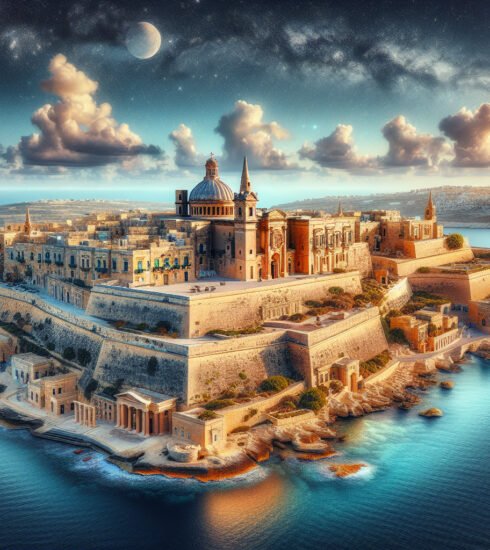Unveiling Maltas Time Portal: Discover the Enthralling Stories of Ancient Heritage | Article
Introduction
Malta, a jewel in the heart of the Mediterranean, is a country that embodies a rich tapestry of history and heritage. The small island archipelago has witnessed the rise and fall of ancient civilizations, making it a fascinating destination for history enthusiasts and curious travelers alike. One of the most captivating aspects of Malta’s historical legacy is its incredible array of ancient sites and ruins that act as portals to the past. In this article, we will embark on a journey through Malta’s time portal, uncovering the vibrant stories of ancient heritage that lie within.
The Temples of Malta: A Testament to Ancient Civilizations
The temples of Malta are a testament to the island’s rich and diverse history, dating back thousands of years. The most famous of these temples is the UNESCO World Heritage site of Ħaġar Qim, located on the southern coast of Malta. Built between 3600 and 3200 BC, Ħaġar Qim is a megalithic temple complex that stands as a remarkable feat of engineering and architectural prowess. The intricate stonework, massive slabs of limestone, and perfectly aligned entrances and alignments make it a true marvel of ancient craftsmanship.
Another prominent temple in Malta is the Mnajdra Temple, located just a short distance away from Ħaġar Qim. Dating back to the same period, Mnajdra is a collection of three temples that showcase the ingenuity and artistic skill of our ancestors. The temples feature intricate carvings, altars, and chambers that were used for various rituals and ceremonies. Exploring these temples provides a glimpse into the spiritual and cultural practices of Malta’s ancient civilizations.
The Ggantija Temples, located on the island of Gozo, are yet another remarkable example of ancient architecture on the Maltese islands. Dating back to 3600-3200 BC, the Ggantija Temples are among the oldest freestanding structures in the world, predating the Great Pyramids of Egypt and Stonehenge. The temples consist of two separate structures that were dedicated to the worship of a fertility goddess, and they provide invaluable insights into the daily lives and beliefs of the people who built them.
Related article for further reading: Malta’s Lore: Exploring the Legends and Myths
The Silent City of Mdina: Treading the Streets of Medieval Malta
Nestled on a hilltop, surrounded by towering fortifications, lies the ancient city of Mdina. Known as the ‘Silent City,’ Mdina is a living testament to Malta’s medieval past. As one of Europe’s finest examples of an ancient walled city, Mdina offers visitors the opportunity to step back in time and immerse themselves in a bygone era.
Walking through the narrow, winding streets of Mdina, you can’t help but feel as if you’ve been transported to a medieval fairytale. The city’s impressive architecture, cobblestone streets, and stunning cathedrals create an atmosphere of enchantment and nostalgia. The magnificent St. Paul’s Cathedral, with its ornate Baroque interior and commanding presence, is a must-visit for history buffs and art enthusiasts.
Exploring the city’s bastions gives visitors stunning panoramic views of the surrounding countryside, allowing them to fully appreciate the strategic significance of Mdina throughout history. With its imposing fortifications and elevated position, Mdina served as the island’s capital for several centuries, witnessing numerous battles and conquests.
Related article for further reading: Malta’s Enigmatic Ruins: Unraveling the Mysteries of the Past
The Grand Harbor: A Gateway to Malta’s Maritime Heritage
The Grand Harbor in Valletta is not just a picturesque harbor; it is also a living testament to Malta’s maritime heritage. Throughout history, the Grand Harbor has played a crucial role in shaping Malta’s destiny. From the Phoenicians to the Knights of St. John and the British Empire, this natural harbor has been a strategic port for centuries.

The harbor is lined with a multitude of architectural marvels, including the imposing Fort Saint Angelo. Perched atop a promontory overlooking the harbor, this fort has witnessed countless battles and sieges. It was the seat of power for the Knights of St. John and played a vital role in protecting the island from invading forces.
Another remarkable structure in the Grand Harbor is the Saluting Battery. Located on the upper part of the harbor, the battery was originally built by the Knights of St. John and was used to salute incoming and outgoing ships. Today, visitors can witness the firing of the cannons at the Saluting Battery, a tradition that has been preserved for centuries.
The Grand Harbor is also home to the majestic Fort Saint Elmo, which guards the entrance to the harbor. Built by the Knights of St. John in the 16th century, Fort Saint Elmo played a crucial role during the Great Siege of Malta, when the Ottoman Empire attempted to capture the island. Today, the fort houses the National War Museum, allowing visitors to delve into the fascinating military history of Malta.
The Hypogeum of Ħal-Saflieni: A Subterranean World of Mystery
The Hypogeum of Ħal-Saflieni is a UNESCO World Heritage site and an extraordinary underground complex that carries with it an air of mystery and intrigue. Discovered accidentally in 1902, the Hypogeum is a subterranean temple that dates back to around 2500 BC, making it one of the oldest prehistoric underground temples in the world.
Descend into the depths of the Hypogeum, and you will find yourself in an otherworldly realm of perfectly carved chambers, galleries, and burial chambers. The intricate carvings, paintings, and the unique acoustic properties of the temple provide invaluable insights into the spiritual beliefs and practices of Malta’s ancient inhabitants.
The Hypogeum is believed to have been used for various rituals and ceremonies, including burial rites. The discovery of over 7,000 human remains within the complex suggests that it was an important place of worship and reverence for the ancient people of Malta. The exceptional preservation of the Hypogeum gives us a rare glimpse into the rituals and beliefs of our ancestors.
The Citadel of Victoria: Exploring Gozo’s Historic Heart
Perched on a hilltop in the heart of Gozo stands the Citadel of Victoria, a fortified city that has been a central hub of activity for centuries. With its imposing bastions, narrow alleyways, and splendid medieval architecture, the Citadel is a living testament to Gozo’s rich history and heritage.
Enter through the Citadel’s massive fortified walls, and you will be transported back in time. The labyrinthine streets reveal hidden treasures at every turn, from ornate palaces to charming churches and quaint shops selling traditional crafts. The awe-inspiring views from the Citadel’s ramparts provide a breathtaking panorama of the Gozitan countryside and the surrounding Mediterranean Sea.
The Citadel has served as a place of refuge and defense throughout history. It offered shelter during pirate raids and Ottoman invasions, providing a safe haven for the island’s inhabitants. Today, the Citadel is a thriving community, home to a number of museums, galleries, and cultural events that celebrate Gozo’s unique heritage.
Conclusion
Embarking on a journey through Malta’s time portal is like stepping into a living history book. From the ancient temples that speak of a time long gone to the medieval cities that still resonate with the echoes of the past, Malta is a treasure trove of ancient heritage. The stories held within its ancient sites and ruins open a window into the lives and beliefs of our ancestors, allowing us to connect with the vibrant tapestry of Malta’s history.
Whether you’re fascinated by megalithic temples, enchanted by medieval cities, or intrigued by underground crypts, Malta offers a diverse range of historical sites that will leave you in awe. So, step through Malta’s time portal and uncover the vibrant stories of ancient heritage that lie within. Your journey through the past awaits.
Link to relevant Wikipedia page: Valletta





